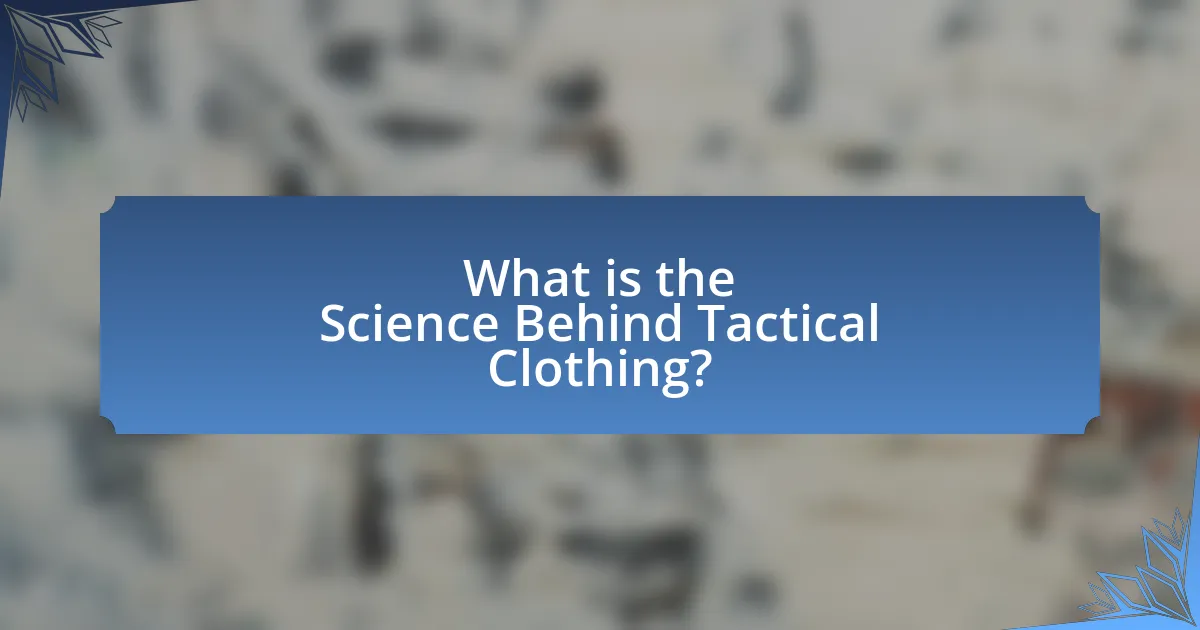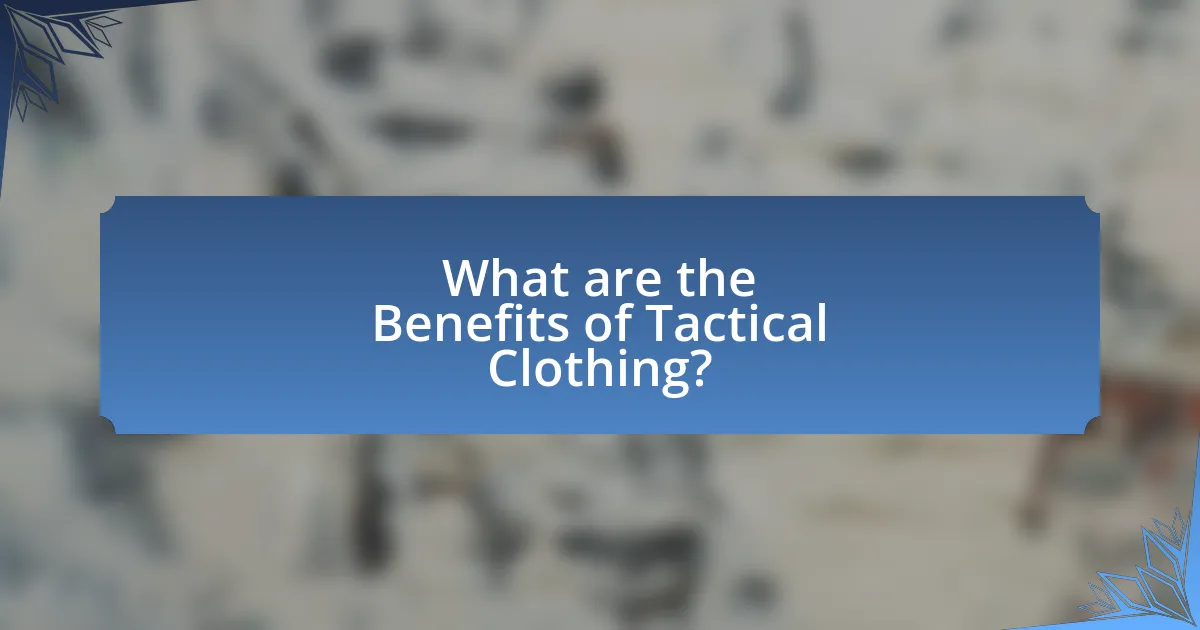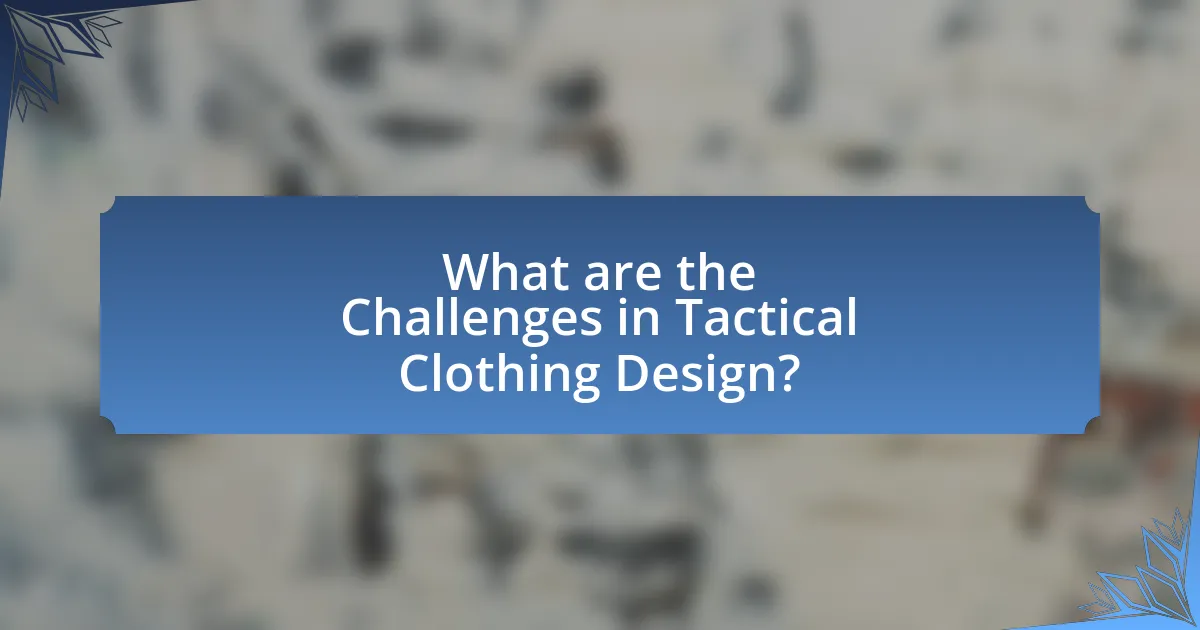Tactical clothing is engineered for performance, durability, and functionality in demanding environments, utilizing advanced materials such as nylon and polyester. Key features include reinforced stitching, ergonomic designs, and specialized coatings that enhance usability and comfort. The article explores how tactical clothing differs from regular apparel, the importance of materials and design principles, and the role of technology in improving functionality. It also addresses the challenges in design, material selection, and user feedback mechanisms that shape future innovations in tactical clothing, highlighting its applications in military, law enforcement, and outdoor activities.

What is the Science Behind Tactical Clothing?
Tactical clothing is designed using advanced materials and engineering principles to enhance performance, durability, and functionality in demanding environments. The science behind tactical clothing involves the integration of high-performance fabrics, such as nylon and polyester, which provide strength, abrasion resistance, and moisture-wicking properties. Additionally, features like reinforced stitching, ergonomic designs, and specialized coatings for water and stain resistance are employed to optimize usability and comfort. Research indicates that these materials can significantly improve the wearer’s mobility and protection, as evidenced by studies showing that tactical gear can reduce injury rates in high-risk occupations.
How does tactical clothing differ from regular clothing?
Tactical clothing differs from regular clothing primarily in its design and functionality, as tactical clothing is specifically engineered for durability, versatility, and performance in demanding environments. Tactical clothing often incorporates advanced materials such as ripstop fabric, moisture-wicking technology, and reinforced stitching, which enhance its resistance to wear and tear compared to standard apparel. For instance, tactical pants may feature multiple pockets for utility and accessibility, while regular pants typically prioritize style over functionality. Additionally, tactical clothing is often designed with features like adjustable cuffs, reinforced knees, and integrated body armor compatibility, which are not common in regular clothing. These design elements ensure that tactical clothing meets the rigorous demands of military, law enforcement, and outdoor activities, providing both protection and practicality.
What specific features define tactical clothing?
Tactical clothing is defined by features such as durability, functionality, and adaptability. These garments are typically made from high-strength materials like ripstop nylon or polyester, which provide resistance to wear and tear. Additionally, tactical clothing often includes multiple pockets for storage, reinforced stitching for added strength, and moisture-wicking properties to enhance comfort during physical activity. The design of tactical clothing is also focused on ease of movement, often incorporating features like articulated joints and stretch panels. These characteristics ensure that tactical clothing meets the demands of various environments and activities, making it suitable for military, law enforcement, and outdoor use.
Why is functionality important in tactical clothing?
Functionality is crucial in tactical clothing because it directly impacts the performance and safety of the wearer in high-stakes environments. Tactical clothing is designed to provide essential features such as durability, mobility, and protection, which are vital for military, law enforcement, and outdoor activities. For instance, materials like ripstop nylon and moisture-wicking fabrics enhance durability and comfort, allowing for extended wear in challenging conditions. Additionally, functional design elements such as reinforced seams, multiple pockets, and adjustable features facilitate ease of movement and accessibility to gear, which can be critical in emergency situations. The effectiveness of tactical clothing in real-world applications underscores the importance of its functionality, as evidenced by its widespread use among professionals who rely on these garments for their safety and operational efficiency.
What role do materials play in tactical clothing design?
Materials are crucial in tactical clothing design as they determine functionality, durability, and comfort. High-performance fabrics such as nylon and polyester provide strength and resistance to wear, while moisture-wicking and breathable materials enhance comfort during physical activities. Additionally, specialized coatings like water-repellency and flame resistance are often integrated into these materials to meet specific operational needs. For instance, the use of Cordura fabric, known for its durability, is common in tactical gear, ensuring that clothing can withstand harsh environments and rigorous use.
Which materials are commonly used in tactical clothing?
Tactical clothing commonly utilizes materials such as nylon, polyester, and cotton blends. Nylon is favored for its durability and resistance to abrasion, making it ideal for high-stress environments. Polyester offers moisture-wicking properties and quick-drying capabilities, enhancing comfort during physical activities. Cotton blends provide breathability and comfort, although they may not be as durable as synthetic options. These materials are chosen based on their performance characteristics, ensuring that tactical clothing meets the demands of various operational scenarios.
How do different materials affect performance and durability?
Different materials significantly impact the performance and durability of tactical clothing. For instance, synthetic fabrics like nylon and polyester offer high tensile strength and resistance to abrasion, enhancing durability in rugged environments. In contrast, natural fibers such as cotton provide comfort but may lack the same level of durability and moisture-wicking properties, which can affect performance in demanding situations. Research indicates that nylon can withstand up to 10 times more wear than cotton, making it a preferred choice for tactical applications. Additionally, materials treated with water-repellent coatings improve performance by keeping the wearer dry, further extending the lifespan of the clothing.
What design principles are essential for tactical clothing?
Essential design principles for tactical clothing include functionality, durability, comfort, and adaptability. Functionality ensures that clothing meets specific operational needs, such as pockets for gear and moisture-wicking fabrics for temperature regulation. Durability is critical, as tactical clothing must withstand harsh environments and rigorous use, often utilizing reinforced seams and high-strength materials like nylon or polyester. Comfort is achieved through ergonomic designs that allow for a full range of motion, while adaptability involves features like modular components or adjustable fits that cater to various scenarios. These principles are validated by industry standards and user feedback, emphasizing the importance of performance in tactical applications.
How does ergonomics influence tactical clothing design?
Ergonomics significantly influences tactical clothing design by ensuring that garments enhance comfort, mobility, and functionality for the wearer. Tactical clothing is designed to accommodate a range of movements and activities, which is critical for personnel in high-stress environments. For instance, ergonomic principles guide the placement of seams, pockets, and closures to minimize chafing and maximize accessibility, allowing for quick retrieval of essential gear. Research indicates that well-designed ergonomic clothing can improve performance and reduce fatigue, as seen in studies where military personnel reported increased efficiency and comfort when wearing ergonomically optimized uniforms.
What are the key design elements that enhance usability?
Key design elements that enhance usability include intuitive layout, clear navigation, and responsive design. An intuitive layout allows users to easily understand how to interact with the clothing features, while clear navigation ensures that users can quickly find what they need, such as pockets or adjustments. Responsive design adapts to various body types and movements, enhancing comfort and functionality. Research indicates that usability is significantly improved when these elements are effectively integrated, leading to higher user satisfaction and performance in tactical scenarios.
How do advancements in technology impact tactical clothing?
Advancements in technology significantly enhance tactical clothing by improving materials, functionality, and user safety. Innovations such as moisture-wicking fabrics, lightweight composites, and integrated smart technologies allow tactical clothing to provide better performance in various environments. For instance, the introduction of ripstop nylon and Kevlar has increased durability and protection against abrasions and cuts, which is crucial for military and law enforcement personnel. Additionally, the integration of features like temperature regulation and moisture management systems has been shown to improve comfort and effectiveness during prolonged use, as evidenced by studies highlighting the importance of environmental adaptability in tactical gear.
What innovations are shaping the future of tactical clothing?
Innovations shaping the future of tactical clothing include advanced materials, smart textiles, and modular designs. Advanced materials such as lightweight, breathable, and moisture-wicking fabrics enhance comfort and performance in various environments. Smart textiles integrate technology, allowing for features like temperature regulation and embedded sensors for monitoring health metrics. Modular designs enable customization and adaptability, allowing users to modify their gear based on mission requirements. These innovations are supported by research indicating that the integration of technology and improved materials significantly enhances the functionality and effectiveness of tactical clothing in real-world applications.

What are the Benefits of Tactical Clothing?
Tactical clothing offers enhanced durability, functionality, and comfort for users in demanding environments. The materials used in tactical clothing, such as ripstop nylon and moisture-wicking fabrics, provide resistance to wear and tear while ensuring breathability. Additionally, tactical clothing often includes features like multiple pockets, reinforced seams, and adjustable components, which improve usability and adaptability in various situations. Studies have shown that the right tactical gear can significantly enhance performance and safety in fields such as law enforcement and military operations, where reliability and efficiency are critical.
How does tactical clothing enhance user performance?
Tactical clothing enhances user performance by providing specialized features that improve mobility, durability, and functionality in demanding environments. The use of lightweight, breathable materials allows for better temperature regulation and comfort, which is crucial during extended periods of activity. Additionally, tactical clothing often incorporates reinforced stitching and abrasion-resistant fabrics, ensuring longevity and protection against wear and tear. For instance, garments made from ripstop nylon can withstand harsh conditions without compromising flexibility. Furthermore, the strategic placement of pockets and attachment points facilitates easy access to essential gear, thereby increasing efficiency in critical situations. These design elements collectively contribute to improved user performance in tactical scenarios.
What specific scenarios benefit from tactical clothing?
Tactical clothing benefits specific scenarios such as military operations, law enforcement activities, outdoor survival situations, and tactical sports. In military operations, tactical clothing provides durability and functionality, allowing soldiers to perform effectively in diverse environments. Law enforcement personnel utilize tactical clothing for its protective features and ease of movement during high-stress situations. Outdoor survival scenarios benefit from tactical clothing’s weather resistance and multi-pocket designs, which facilitate carrying essential gear. Additionally, tactical sports, such as airsoft and paintball, require specialized clothing that enhances mobility and provides protection during competitive play. These scenarios highlight the practical applications of tactical clothing, demonstrating its importance in various high-demand environments.
How does tactical clothing improve safety and protection?
Tactical clothing improves safety and protection by utilizing specialized materials and designs that enhance durability, resistance to environmental hazards, and functionality. These garments often incorporate features such as reinforced stitching, abrasion-resistant fabrics, and moisture-wicking properties, which collectively reduce the risk of injury in demanding situations. For instance, many tactical pants are made from ripstop nylon, which is designed to prevent tearing and withstand rough conditions, thereby providing a protective barrier against cuts and abrasions. Additionally, tactical clothing often includes pockets and attachment points for carrying essential gear, allowing for quick access to tools and equipment, which can be crucial in emergency scenarios.
What industries utilize tactical clothing the most?
The industries that utilize tactical clothing the most include law enforcement, military, outdoor recreation, and security services. Law enforcement agencies require tactical clothing for operational readiness and safety, while military personnel depend on durable and functional gear for combat situations. Outdoor recreation enthusiasts, such as hikers and campers, often choose tactical clothing for its practicality and resilience in various environments. Security services also rely on tactical apparel to ensure personnel are equipped for potential threats and emergencies. These industries prioritize functionality, durability, and protection, which are key characteristics of tactical clothing.
Which professions require specialized tactical clothing?
Professions that require specialized tactical clothing include law enforcement officers, military personnel, security professionals, and emergency responders. These roles necessitate clothing designed for durability, protection, and functionality in high-stress environments. For instance, military personnel often wear tactical gear made from ripstop fabric to withstand harsh conditions, while law enforcement officers may utilize ballistic vests for protection against firearms. Emergency responders, such as firefighters and paramedics, require clothing that offers thermal protection and high visibility. The specific design and materials used in tactical clothing are critical for ensuring safety and performance in these demanding professions.
How does tactical clothing cater to outdoor enthusiasts?
Tactical clothing caters to outdoor enthusiasts by providing specialized features that enhance performance, durability, and comfort in challenging environments. These garments are often made from high-performance materials such as ripstop nylon and moisture-wicking fabrics, which offer resistance to wear and tear while ensuring breathability. Additionally, tactical clothing typically includes functional design elements like multiple pockets for storage, reinforced stitching for added strength, and adjustable components for a customizable fit. These features are essential for outdoor activities, as they allow enthusiasts to carry gear efficiently and adapt to varying weather conditions, thereby improving their overall experience and safety in the field.

What are the Challenges in Tactical Clothing Design?
The challenges in tactical clothing design include balancing functionality, durability, and comfort. Designers must ensure that the clothing can withstand harsh environments while providing ease of movement and breathability. For instance, materials must be resistant to abrasion and water while also being lightweight to facilitate mobility. Additionally, integrating features such as pockets, zippers, and adjustable components without compromising the garment’s overall performance poses a significant challenge. Research indicates that tactical clothing must also meet specific military standards, which adds complexity to the design process, as seen in the U.S. Army’s requirements for operational effectiveness in various climates.
What are the common issues faced in material selection?
Common issues faced in material selection include cost constraints, performance requirements, and environmental impact. Cost constraints often limit the options available, forcing designers to choose materials that may not meet all performance criteria. Performance requirements, such as durability, breathability, and water resistance, can complicate the selection process, as not all materials excel in every area. Environmental impact is increasingly significant, with the need to consider sustainability and recyclability of materials, which can further narrow the choices. These factors collectively create challenges in achieving the optimal balance between functionality, cost, and ecological responsibility in tactical clothing design.
How do environmental factors affect material performance?
Environmental factors significantly influence material performance by affecting properties such as strength, durability, and flexibility. For instance, exposure to extreme temperatures can lead to thermal expansion or contraction, which may compromise the integrity of materials used in tactical clothing. Additionally, humidity can cause materials to absorb moisture, leading to degradation or loss of structural integrity over time. Research indicates that UV radiation can weaken synthetic fibers, reducing their lifespan and effectiveness. A study published in the Journal of Materials Science found that materials exposed to high levels of moisture and UV light exhibited a 30% reduction in tensile strength compared to those kept in controlled conditions. Thus, understanding these environmental impacts is crucial for selecting appropriate materials in tactical clothing design.
What are the trade-offs between comfort and durability?
The trade-offs between comfort and durability in tactical clothing involve balancing the softness and flexibility of materials against their resistance to wear and tear. Comfort is typically enhanced by using softer fabrics that allow for greater movement and breathability, such as cotton or lightweight synthetics. However, these materials may not withstand harsh conditions or prolonged use as effectively as more durable options like nylon or polyester blends, which offer superior abrasion resistance and longevity. For instance, a study published in the Journal of Textile Science found that while cotton provides excellent comfort, it degrades faster under stress compared to synthetic fibers, which maintain structural integrity over time. Thus, selecting materials for tactical clothing requires careful consideration of the intended use, as prioritizing comfort can compromise durability and vice versa.
How can designers address user needs effectively?
Designers can address user needs effectively by conducting thorough user research to understand specific requirements and preferences. This involves utilizing methods such as surveys, interviews, and usability testing to gather insights directly from the target audience. For instance, a study published in the Journal of Usability Studies found that user-centered design approaches significantly improve product satisfaction and usability. By integrating feedback from users into the design process, designers can create tactical clothing that meets functional demands, enhances comfort, and aligns with user expectations.
What feedback mechanisms are used to improve tactical clothing?
Feedback mechanisms used to improve tactical clothing include user surveys, field testing, and performance analytics. User surveys collect direct input from military and law enforcement personnel regarding comfort, functionality, and durability, which informs design adjustments. Field testing involves real-world trials where users evaluate clothing under operational conditions, providing insights into material performance and design effectiveness. Performance analytics utilize data from wear and tear assessments, allowing manufacturers to identify weaknesses in materials and construction. These mechanisms collectively ensure that tactical clothing evolves to meet the demands of users effectively.
How do user experiences shape future designs?
User experiences significantly influence future designs by providing critical feedback that informs improvements and innovations. Designers analyze user interactions, preferences, and pain points to create more functional and user-friendly products. For instance, in the tactical clothing industry, user feedback on comfort, durability, and usability directly leads to the development of advanced materials and design features that enhance performance in real-world scenarios. This iterative process ensures that future designs are better aligned with user needs, ultimately resulting in higher satisfaction and effectiveness in tactical applications.
What are the best practices for choosing tactical clothing?
The best practices for choosing tactical clothing include selecting materials that offer durability, breathability, and moisture-wicking properties. Tactical clothing should be made from high-quality fabrics such as nylon or polyester blends, which provide resistance to wear and tear while allowing for comfort during extended use. Additionally, it is essential to consider the fit and functionality of the clothing; items should allow for a full range of motion and include features like pockets and reinforced areas for practicality. Research indicates that clothing designed with these attributes enhances performance in demanding environments, as evidenced by military and law enforcement applications where functionality and resilience are critical.


